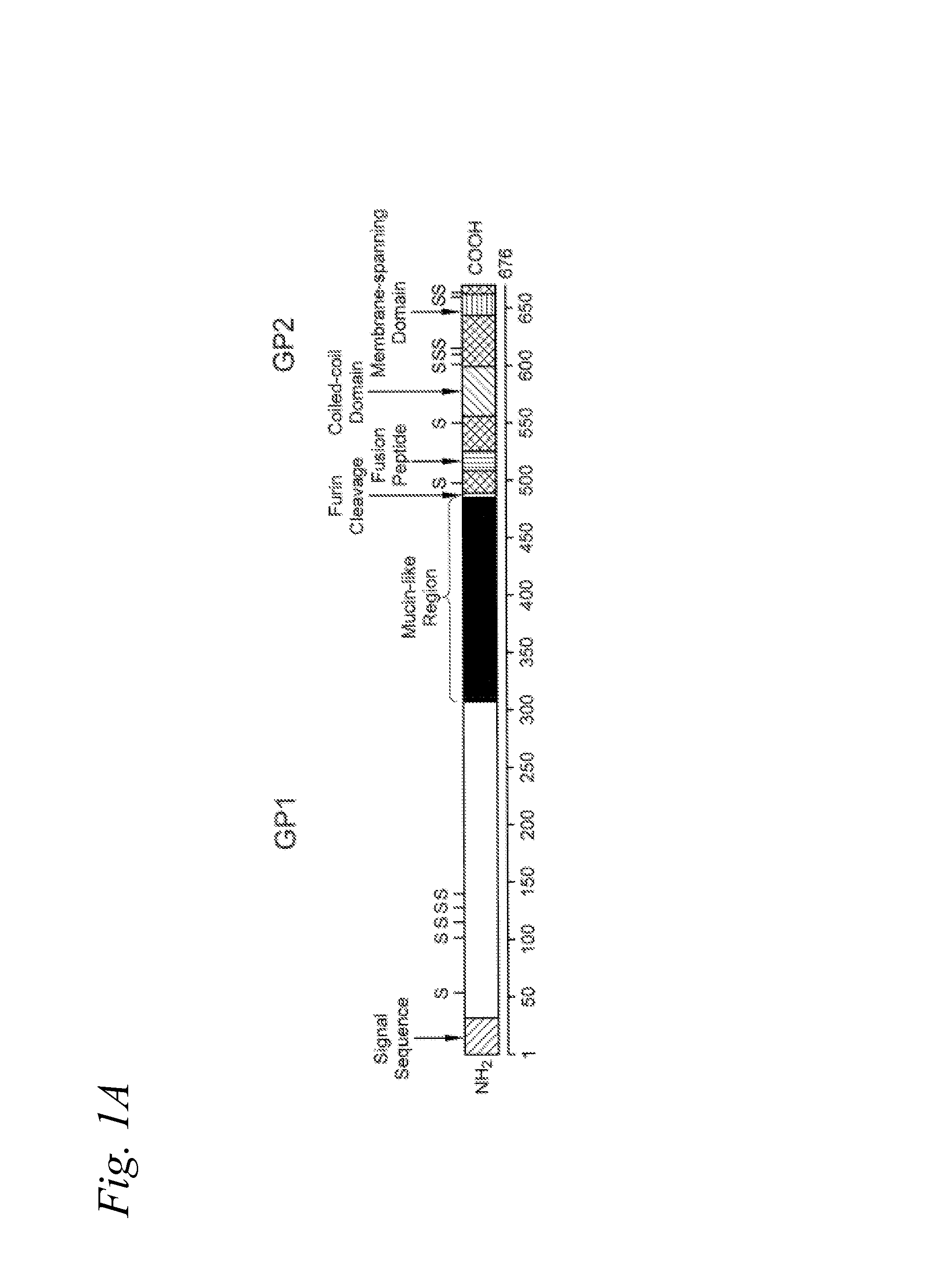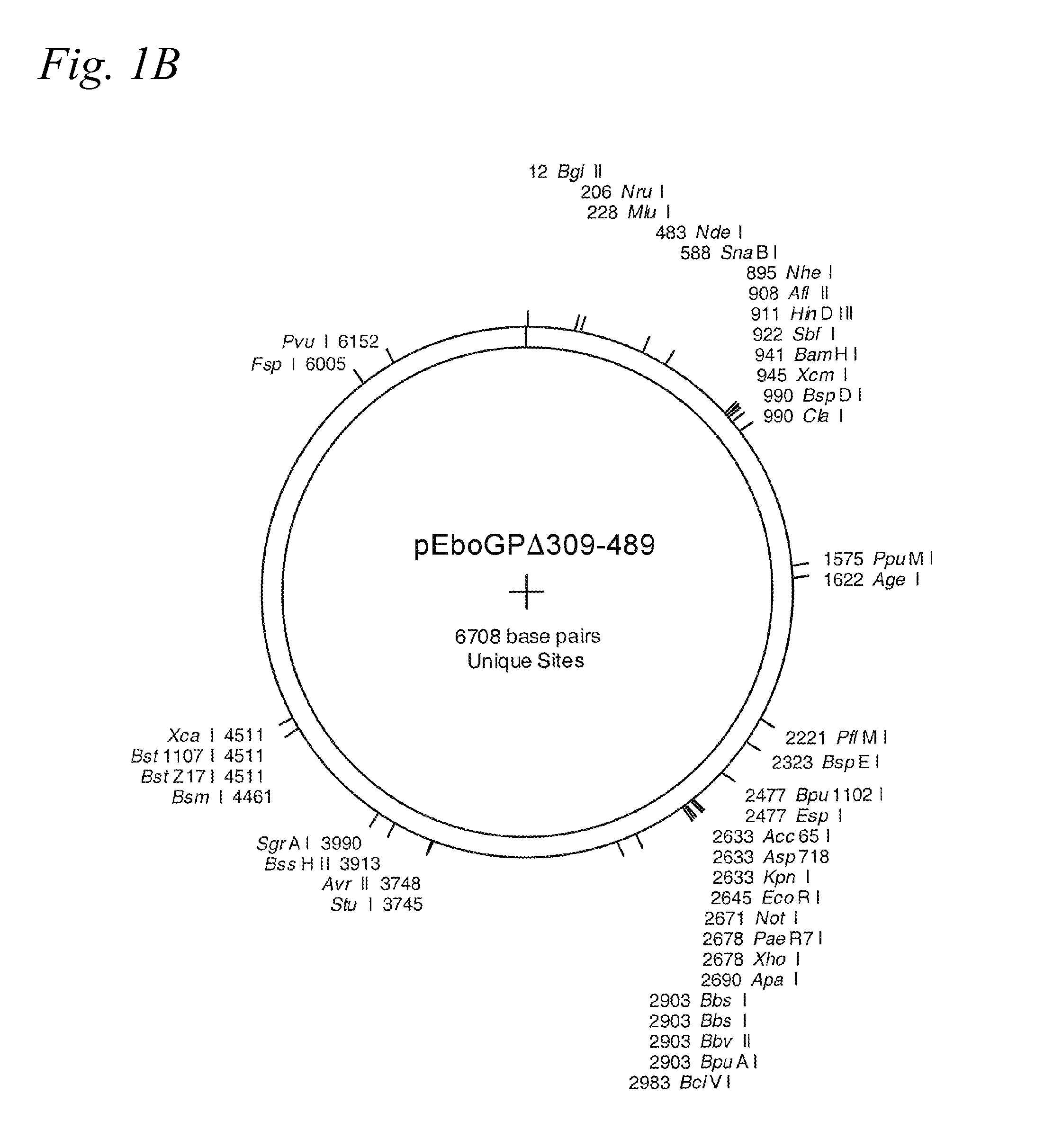Pseudotyped retrovirus with modified ebola glycoprotein
a retrovirus and glycoprotein technology, applied in the field of pseudotyped viruses, can solve the problems of retroviruses that do not have a broad host range, cells can only produce viruses for a limited time, and design vectors that are both safe and effective, and achieve the effects of stable production, improved titer, and improved titer
- Summary
- Abstract
- Description
- Claims
- Application Information
AI Technical Summary
Benefits of technology
Problems solved by technology
Method used
Image
Examples
example i
Murine Leukemia Virus Pseudotyped with Ebola Glycoprotein Lacking O-Glycosylation Region
Materials and Methods
[0058]Cell lines and culture conditions. The human kidney cell line 293 (ATCC Number CRL-1573), the mouse embryo cell line NIH 3T3 (CRL-1658), and the 293T-derived φNX (second generation retroviral packaging cells) (Grignani et al., Cancer Res, 58:14-19 (1998); Pear et al., Proc. Natl. Acad. Sci. USA, 90:8392-8396 (1993); Swift et al., p. 10.17.14-10.17.29. In R. Coico (ed.), Current Protocols in Immunology supp. 31. J. Wiley & Sons (1999)) and gpnlslacZ cell lines were cultured in Dulbecco's minimal essential medium (DMEM) containing 10% heat inactivated fetal bovine serum, 2 mM glutamine, 100 units Penicillin G, and 100 μg / ml streptomycin sulfate, with or without 0.25 μg / ml amphotericin B (growth medium). The gpnlslacZ cells produce envelope protein-deficient replication-incompetent Mo-MuLV particles carrying MFG.S-nlslacZ, a retroviral vector encoding a nuclear localizing ...
example ii
Expression of Green Fluorescent Protein in Target Cells Transduced with Pseudotyped Retrovirus
[0066]A plasmid was constructed based on pcDNA3.1 (Invitrogen) expresses the Ebola virus (Zaire strain) glycoprotein with its O-glycosylation region deleted (amino acids 309-489), under control of the cytomegalovirus (CMV) promoter. pcDNA3.1 is similar to pcDNA1 but it also contains zeocin resistance. This plasmid was transfected into human cell lines (gpGFP, Taylor et al., Mol. Biol. Cell, 10:2803-2815 (1999)) that have also been transfected with genes encoding the Moloney murine leukemia virus (Mo-MuLV) gag and pol (including pro) genes, the plasmid MFG.S-GFP, and a gene encoding the A. Victoria green fluorescent protein (GFP).
[0067]Recombinant pseudotyped retrovirus recovered from the supernatant medium of such cells was incubated with several different cell lines (a murine cell line, NIH3T3; a human cell line, HeLa; and a hamster cell line, BHK) and was shown to be capable of introducin...
example iii
Feline Immunodeficiency Virus Pseudotyped with Ebola Glycoprotein Lacking O-Glycosylation Region
[0068]Feline immunodeficiency virus (FIV)-based vectors, which are a non-primate lentivirus vectors, were pseudotyped using envelope glycoproteins (GPs) from the filoviruses Marburg and Ebola virus (Sinn et al., J Virol 2003 May 15; 77(10):5902-10). We observed that primary cultures of well-differentiated human airway epithelia were transduced when filovirus GP pseudotyped FIV was applied to the apical surface. Furthermore, by deleting a heavily O-glycosylated extracellular region of the Ebola GP, we improved the titer of concentrated vector several fold.
[0069]Vector production. The second-generation FIV vector system utilized in this study was reported previously (Johnston et al., J. Virol. 73:4991-5000 (1999) and Wang et al., J. Clin. Inv. 104:R55-62 (1999)). The FIV vector construct expressed the β-galactosidase cDNA directed by the CMV promoter. EBOΔO (pEZGP 309-489) has been previous...
PUM
| Property | Measurement | Unit |
|---|---|---|
| temperature | aaaaa | aaaaa |
| bioactive | aaaaa | aaaaa |
| time | aaaaa | aaaaa |
Abstract
Description
Claims
Application Information
 Login to view more
Login to view more - R&D Engineer
- R&D Manager
- IP Professional
- Industry Leading Data Capabilities
- Powerful AI technology
- Patent DNA Extraction
Browse by: Latest US Patents, China's latest patents, Technical Efficacy Thesaurus, Application Domain, Technology Topic.
© 2024 PatSnap. All rights reserved.Legal|Privacy policy|Modern Slavery Act Transparency Statement|Sitemap



